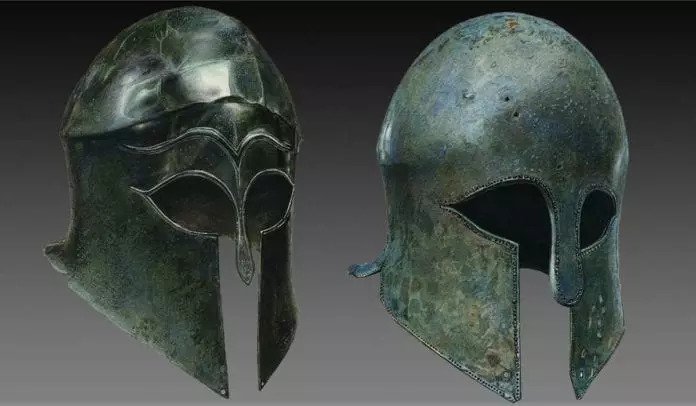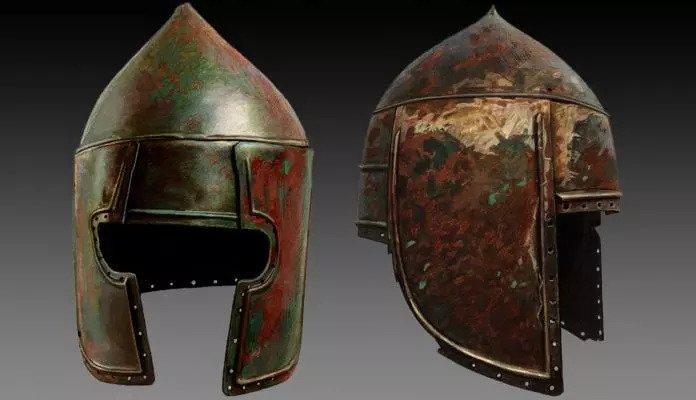Helmets have been an essential part of human history, serving as a symbol of protection and strength across various cultures and eras. Whether worn by ancient warriors, medieval knights, or modern-day motorcyclists, helmets have evolved significantly over time, adapting to new technologies, materials, and safety needs. In this article, we will take a journey through the history of helmets, exploring how they have developed from ancient protective gear to the high-tech helmets worn by cyclists, motorcyclists, and athletes today.

Ancient Beginnings: Helmets as Protection for Warriors
The earliest evidence of helmet usage dates back thousands of years, where helmets were used primarily for protection during battle. In ancient civilizations, warriors and soldiers used various types of helmets made from available materials such as bronze, iron, leather, and even wood. These early helmets were designed to protect the head during combat, which was vital for survival in battle.
Ancient Egypt and Mesopotamia
In ancient Egypt, soldiers wore simple headgear made from linen or leather, sometimes reinforced with metal. These early helmets were more about symbolizing rank and status than providing full protection, as they were often adorned with elaborate designs and inscriptions.
In ancient Mesopotamia, helmets were more functional and were often made from bronze or copper. These helmets were designed to protect the wearer from blows during combat, with some featuring metal cheek guards to protect the sides of the face.
Greek and Roman Helmets
The ancient Greeks and Romans are perhaps most famous for their use of helmets in battle. The Greek hoplite soldiers wore helmets made from bronze, with designs that included a crest on top, often decorated with feathers or horsehair. These helmets were intended to protect the head, face, and neck, while also being lightweight enough to allow the soldiers to move quickly and effectively in combat.
The Romans took helmet design to the next level with their galea, a helmet made from bronze or iron, which featured a broad brim and cheek guards. Roman helmets were highly functional and provided significant protection to soldiers during combat. They were often designed with ventilation holes to reduce heat buildup, allowing soldiers to endure the harsh conditions of battle for longer periods.
Medieval Helmets: From Conical to Full-Faced Protection
The Middle Ages marked a significant advancement in helmet design. As warfare evolved, so did the need for better protection. Knights, in particular, required helmets that could withstand heavy blows from swords, axes, and arrows. Helmets during this period were made from iron or steel, and they ranged from simple conical shapes to complex designs meant to offer full protection.
The Norman Helmet
One of the earliest medieval helmets was the Norman helmet, which was commonly worn by warriors during the 10th and 11th centuries. The Norman helmet was typically made from iron and had a simple conical shape that protected the top of the head. Over time, it evolved into a more rounded shape, which offered better protection for the skull.
The Great Helm
As the need for better protection grew, the great helm became a popular choice during the 12th and 13th centuries. The great helm was a large, cylindrical helmet that fully enclosed the head and provided protection for the face, neck, and shoulders. It was made of iron or steel and often featured a faceplate with small slits for vision and breathing. Though highly effective in protecting the wearer, the great helm was heavy and could be difficult to wear for extended periods.
The Bascinet and Visored Helmets
During the late Middle Ages, the bascinet helmet emerged. This helmet was lighter than the great helm and featured a more fitted design. The bascinet had a pointed top and was often paired with a visor, which could be raised or lowered to reveal the face. This combination of lightness, comfort, and protection made it one of the most popular helmets for knights and soldiers during the 14th century.

The Renaissance and Early Modern Periods: Helmets for the Elite
As the Renaissance period ushered in new advancements in technology and warfare, helmets began to see more personalized designs, with an emphasis on appearance as much as on protection. During this time, the rise of firearms and gunpowder in warfare led to a shift in how helmets were designed. While swords and axes had been the primary weapons in earlier centuries, firearms now posed a new threat, requiring helmets to adapt to this changing landscape.
The Morion and Spanish Helmets
During the 16th century, the morion helmet became widely popular among Spanish soldiers and mercenaries. This helmet was characterized by its distinctive crest, which ran along the top, providing added protection from strikes to the head. The morion was made from steel and was often worn with a wide-brimmed hat or neck guard to protect against falling debris and blows.
The Pickelhaube
In the 19th century, the Pickelhaube, or spiked helmet, became a symbol of German military power. This helmet, made of leather or metal, featured a tall spike on top and was primarily used by German soldiers during the Napoleonic Wars and the early stages of World War I. While the Pickelhaube was a symbol of authority, it was not as practical as other helmets, and it was eventually replaced by more modern designs.
The Modern Era: Helmets for Riders and Athletes
The industrial revolution and the advent of motor vehicles in the 19th and 20th centuries brought about new challenges for helmet design. No longer were helmets used solely for protection in battle – they were now essential for protecting riders, athletes, and even workers in various industries.
Motorcycle Helmets
With the rise of motorcycles in the early 20th century, the need for protective headgear became critical. The first motorcycle helmets were often little more than leather caps, offering minimal protection. In the 1940s and 1950s, helmets began to evolve, with manufacturers using materials like fiberglass and hard plastics to create more durable and protective helmets. These helmets featured a full-face design that offered protection to the jaw and face in addition to the skull.
By the 1960s, the importance of motorcycle helmet safety became more widely recognized, leading to the introduction of standardized helmet regulations and certifications. Modern motorcycle helmets are now made from advanced materials like carbon fiber, Kevlar, and polycarbonate, and are equipped with features such as ventilation systems, impact-absorbing foam, and aerodynamic designs.
Bicycle Helmets and Sports Gear
As cycling grew in popularity in the mid-20th century, the demand for high-quality protective gear increased. Early bicycle helmets were bulky and uncomfortable, but advancements in materials such as polystyrene foam allowed for the development of lightweight, well-ventilated helmets. Today, bicycle helmets are designed to be aerodynamic, lightweight, and highly effective in absorbing impact during falls or accidents.
In addition to motorcycle and bicycle helmets, helmets are now essential gear for many other sports, including skateboarding, skiing, and snowboarding. These helmets have been designed with specific safety needs in mind, offering protection against concussions and other head injuries.
The Future of Helmets: High-Tech Safety Features
As helmet technology continues to advance, we are seeing the integration of new features that enhance safety and comfort. Modern helmets are equipped with cutting-edge technologies, including:
- MIPS (Multi-directional Impact Protection System): This system is designed to reduce rotational forces that can cause brain injuries during an impact.
- Smart Helmets: These helmets feature integrated communication systems, LED lights, and even augmented reality displays, offering both safety and convenience for riders and athletes.
- 3D-Printed Helmets: Advances in 3D printing technology are allowing for more customizable and precise helmet designs, ensuring optimal fit and safety.
Conclusion: Helmets Through the Ages
From their origins as primitive head coverings for ancient warriors to the sophisticated, high-tech designs of today, helmets have come a long way in providing essential protection. Whether worn for military purposes, sporting activities, or commuting, helmets continue to play a vital role in safeguarding individuals from head injuries. As technology advances, the future of helmets looks even brighter, with innovations that promise to make helmets lighter, safer, and more comfortable than ever before. Understanding the history of helmets not only gives us an appreciation for their importance but also underscores the continuing evolution of safety gear for riders and athletes worldwide.


